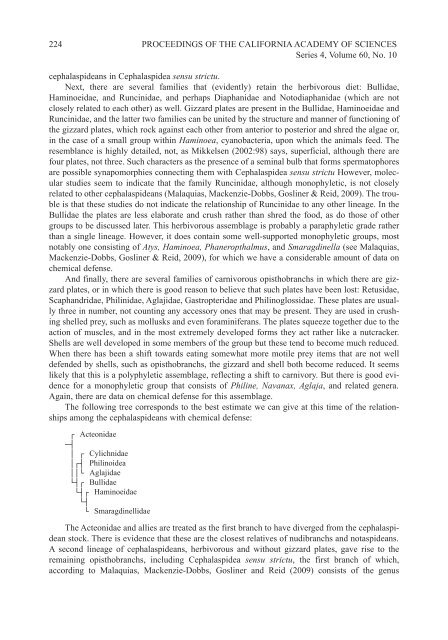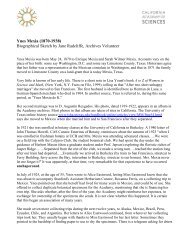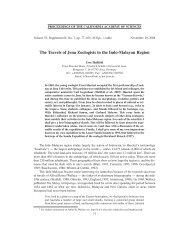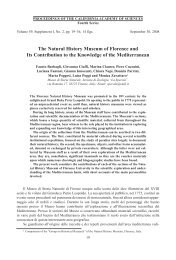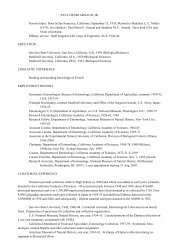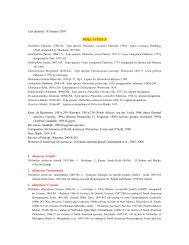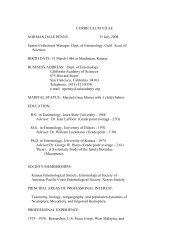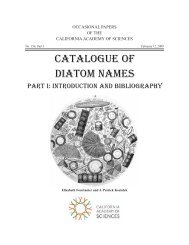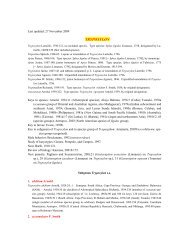Cimino&Ghiselin-tmpZXYZ:Template Proceedings_1.qxd.qxd
Cimino&Ghiselin-tmpZXYZ:Template Proceedings_1.qxd.qxd
Cimino&Ghiselin-tmpZXYZ:Template Proceedings_1.qxd.qxd
You also want an ePaper? Increase the reach of your titles
YUMPU automatically turns print PDFs into web optimized ePapers that Google loves.
224 PROCEEDINGS OF THE CALIFORNIA ACADEMY OF SCIENCES<br />
Series 4, Volume 60, No. 10<br />
cephalaspideans in Cephalaspidea sensu strictu.<br />
Next, there are several families that (evidently) retain the herbivorous diet: Bullidae,<br />
Haminoeidae, and Runcinidae, and perhaps Diaphanidae and Notodiaphanidae (which are not<br />
closely related to each other) as well. Gizzard plates are present in the Bullidae, Haminoeidae and<br />
Runcinidae, and the latter two families can be united by the structure and manner of functioning of<br />
the gizzard plates, which rock against each other from anterior to posterior and shred the algae or,<br />
in the case of a small group within Haminoea, cyanobacteria, upon which the animals feed. The<br />
resemblance is highly detailed, not, as Mikkelsen (2002:98) says, superficial, although there are<br />
four plates, not three. Such characters as the presence of a seminal bulb that forms spermatophores<br />
are possible synapomorphies connecting them with Cephalaspidea sensu strictu However, molecular<br />
studies seem to indicate that the family Runcinidae, although monophyletic, is not closely<br />
related to other cephalaspideans (Malaquias, Mackenzie-Dobbs, Gosliner & Reid, 2009). The trouble<br />
is that these studies do not indicate the relationship of Runcinidae to any other lineage. In the<br />
Bullidae the plates are less elaborate and crush rather than shred the food, as do those of other<br />
groups to be discussed later. This herbivorous assemblage is probably a paraphyletic grade rather<br />
than a single lineage. However, it does contain some well-supported monophyletic groups, most<br />
notably one consisting of Atys, Haminoea, Phaneropthalmus, and Smaragdinella (see Malaquias,<br />
Mackenzie-Dobbs, Gosliner & Reid, 2009), for which we have a considerable amount of data on<br />
chemical defense.<br />
And finally, there are several families of carnivorous opisthobranchs in which there are gizzard<br />
plates, or in which there is good reason to believe that such plates have been lost: Retusidae,<br />
Scaphandridae, Philinidae, Aglajidae, Gastropteridae and Philinoglossidae. These plates are usually<br />
three in number, not counting any accessory ones that may be present. They are used in crushing<br />
shelled prey, such as mollusks and even foraminiferans. The plates squeeze together due to the<br />
action of muscles, and in the most extremely developed forms they act rather like a nutcracker.<br />
Shells are well developed in some members of the group but these tend to become much reduced.<br />
When there has been a shift towards eating somewhat more motile prey items that are not well<br />
defended by shells, such as opisthobranchs, the gizzard and shell both become reduced. It seems<br />
likely that this is a polyphyletic assemblage, reflecting a shift to carnivory. But there is good evidence<br />
for a monophyletic group that consists of Philine, Navanax, Aglaja, and related genera.<br />
Again, there are data on chemical defense for this assemblage.<br />
The following tree corresponds to the best estimate we can give at this time of the relationships<br />
among the cephalaspideans with chemical defense:<br />
┌ Acteonidae<br />
─┤<br />
│ ┌ Cylichnidae<br />
│┌┤ Philinoidea<br />
││└ Aglajidae<br />
└┤┌ Bullidae<br />
└┤┌ Haminoeidae<br />
└┤<br />
└ Smaragdinellidae<br />
The Acteonidae and allies are treated as the first branch to have diverged from the cephalaspidean<br />
stock. There is evidence that these are the closest relatives of nudibranchs and notaspideans.<br />
A second lineage of cephalaspideans, herbivorous and without gizzard plates, gave rise to the<br />
remaining opisthobranchs, including Cephalaspidea sensu strictu, the first branch of which,<br />
according to Malaquias, Mackenzie-Dobbs, Gosliner and Reid (2009) consists of the genus


